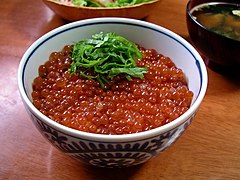Cookbook:Shiso
| Shiso | |
|---|---|
 | |
| Category | Herbs and spices |
Cookbook | Recipes | Ingredients | Equipment | Techniques | Cookbook Disambiguation Pages | Ingredients
Shiso, also called perilla leaf or beefsteak plant, is an aromatic herb used in Japanese, Korean, and Vietnamese cooking. It is from the same family as mint.
Characteristics
[edit | edit source]Shiso leaves are heart-shaped with a toothed edge. They are commonly available in green and red-purple varieties. Both varieties are mildly astringent with flavors basil, cilantro, citrus, clove, and mint. The red leaves are typically slightly more astringent.
Korean varieties, more commonly known as perilla, are larger, broader, and rounder than Japanese shiso varieties.
Procurement and storage
[edit | edit source]Outside of east Asia, shiso leaves can be purchased at specialty Asian grocery stores, especially Japanese and Korean stores. Fresh green shiso is often available year-round, but red shiso tends to be more seasonal. It can also be sold frozen, dried, or packed in oil.
Fresh shiso leaves should be loosely wrapped in a damp cloth and kept in the refrigerated for up to a few days. Freezing will prolong their shelf life.
Use
[edit | edit source]Shiso is common in Japanese, Korean, and Vietnamese cooking. It can also be used in many of the same applications as mint, such as beverages, syrups, and frozen desserts.
Japan
[edit | edit source]In Japan, shiso is often served with sushi and sashimi, and it may separate different items in a platter. It can be used to top soups, rice, and noodles. Green shiso may be dipped in batter and fried to make shiso tempura. Red shiso is often used to color foods, such as umeboshi (pickled plums) and pickled ginger.
Korea
[edit | edit source]Korean perilla leaves can be seasoned, marinated, and served as banchan. They may also be used to wrap pieces of cooked meat, pickled into perilla kimchi, and included in kimbap.
Vietnam
[edit | edit source]Fresh shiso leaves can be included in Vietnamese spring rolls and noodle salads.
Gallery
[edit | edit source]-
Perilla leaf ssam
-
Perilla leaf used to wrap barbecued meat
-
Spaghetti topped with shredded shiso
-
Sushi accompanied by shiso leaves
-
Maki rolls containing hamachi and green shiso
External links
[edit | edit source]- https://www.thespruceeats.com/what-are-shiso-leaves-5112607
- https://www.justonecookbook.com/shiso-perilla/
- https://www.foodrepublic.com/2016/07/13/what-is-shiso-and-how-is-it-used/
- https://www.nytimes.com/1995/05/17/style/whats-that-mysterious-taste-shiso-captivates-chefs.html
- https://www.masterclass.com/articles/shiso-culinary-guide
- https://www.americastestkitchen.com/cooksillustrated/how_tos/10864-what-is-shiso-and-how-do-i-use-it
- https://www.seriouseats.com/seriously-asian-perilla-leaves
- https://specialtyproduce.com/produce/Perilla_Leaves_8555.php
- https://www.carvingajourney.com/what-are-perilla-leaves-perilla-leaves-in-korea/







